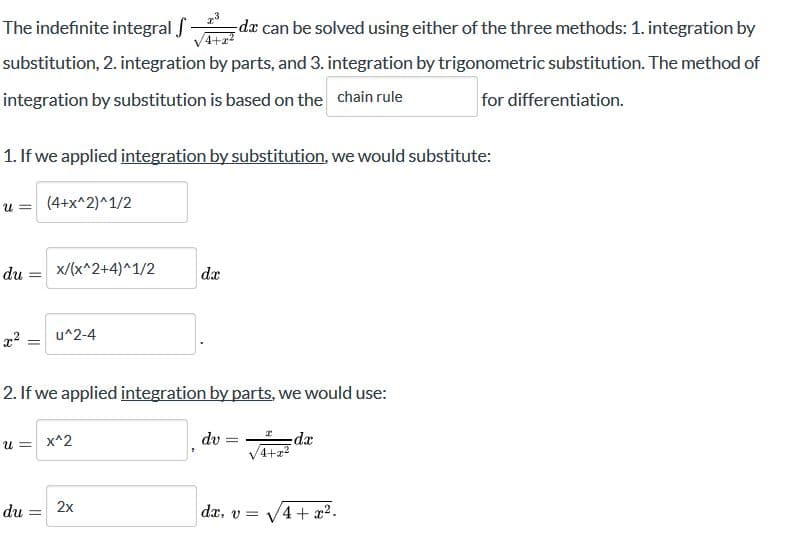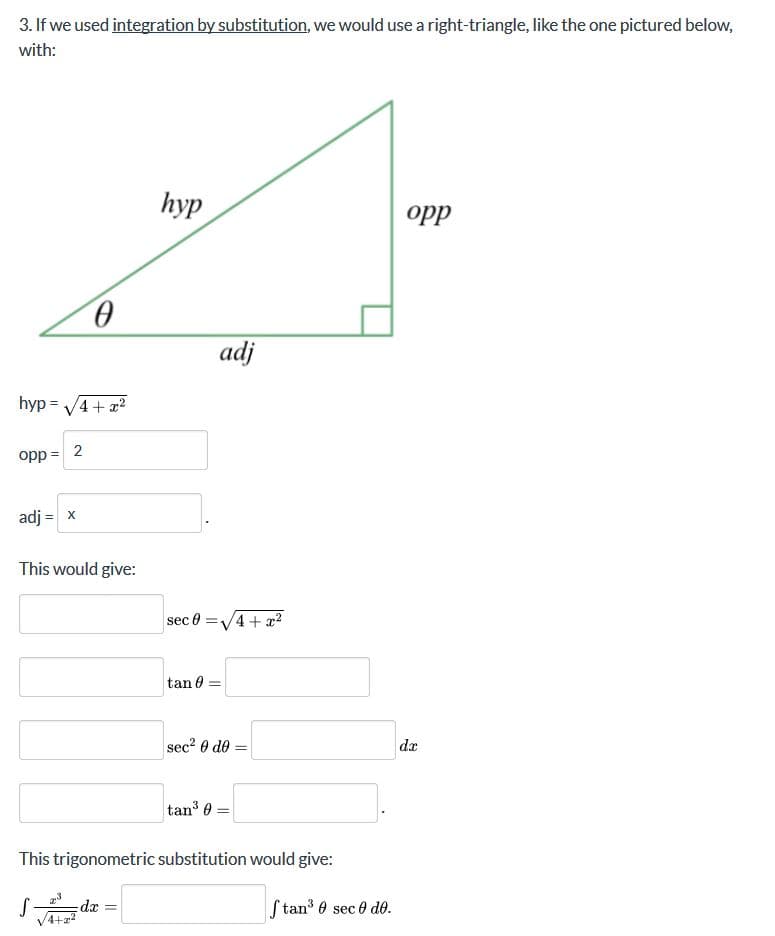The indefinite integral dæ can be solved using either of the three methods: 1. integration by 4+2? substitution, 2. integration by parts, and 3. integration by trigonometric substitution. The method of integration by substitution is based on the chain rule for differentiation. 1. If we applied integration by substitution, we would substitute: u = (4+x^2)^1/2 du x/(x^2+4)^1/2 da u^2-4 %3D 2. If we applied integration by parts, we would use: xp: 4+22 dv = %3D u = x^2 2x du da, v = V4 + x2. %3D 3. If we used integration by substitution, we would use a right-triangle, like the one pictured below, with: hyp opp adj hyp = V4+ x? opp = adj = x This would give: sec 0 =V4 + æ? tan 0 sec? 0 de da tan 0 = This trigonometric substitution would give: xp: V4+z? S tan 0 sec 0 do. 2.
The indefinite integral dæ can be solved using either of the three methods: 1. integration by 4+2? substitution, 2. integration by parts, and 3. integration by trigonometric substitution. The method of integration by substitution is based on the chain rule for differentiation. 1. If we applied integration by substitution, we would substitute: u = (4+x^2)^1/2 du x/(x^2+4)^1/2 da u^2-4 %3D 2. If we applied integration by parts, we would use: xp: 4+22 dv = %3D u = x^2 2x du da, v = V4 + x2. %3D 3. If we used integration by substitution, we would use a right-triangle, like the one pictured below, with: hyp opp adj hyp = V4+ x? opp = adj = x This would give: sec 0 =V4 + æ? tan 0 sec? 0 de da tan 0 = This trigonometric substitution would give: xp: V4+z? S tan 0 sec 0 do. 2.
Calculus: Early Transcendentals
8th Edition
ISBN:9781285741550
Author:James Stewart
Publisher:James Stewart
Chapter1: Functions And Models
Section: Chapter Questions
Problem 1RCC: (a) What is a function? What are its domain and range? (b) What is the graph of a function? (c) How...
Related questions
Question

Transcribed Image Text:The indefinite integral
dæ can be solved using either of the three methods: 1. integration by
4+2?
substitution, 2. integration by parts, and 3. integration by trigonometric substitution. The method of
integration by substitution is based on the chain rule
for differentiation.
1. If we applied integration by substitution, we would substitute:
u = (4+x^2)^1/2
du
x/(x^2+4)^1/2
da
u^2-4
%3D
2. If we applied integration by parts, we would use:
xp:
4+22
dv =
%3D
u = x^2
2x
du
da, v = V4 + x2.
%3D

Transcribed Image Text:3. If we used integration by substitution, we would use a right-triangle, like the one pictured below,
with:
hyp
opp
adj
hyp = V4+ x?
opp =
adj = x
This would give:
sec 0 =V4 + æ?
tan 0
sec? 0 de
da
tan 0 =
This trigonometric substitution would give:
xp:
V4+z?
S tan 0 sec 0 do.
2.
Expert Solution
This question has been solved!
Explore an expertly crafted, step-by-step solution for a thorough understanding of key concepts.
Step by step
Solved in 4 steps with 6 images

Recommended textbooks for you

Calculus: Early Transcendentals
Calculus
ISBN:
9781285741550
Author:
James Stewart
Publisher:
Cengage Learning

Thomas' Calculus (14th Edition)
Calculus
ISBN:
9780134438986
Author:
Joel R. Hass, Christopher E. Heil, Maurice D. Weir
Publisher:
PEARSON

Calculus: Early Transcendentals (3rd Edition)
Calculus
ISBN:
9780134763644
Author:
William L. Briggs, Lyle Cochran, Bernard Gillett, Eric Schulz
Publisher:
PEARSON

Calculus: Early Transcendentals
Calculus
ISBN:
9781285741550
Author:
James Stewart
Publisher:
Cengage Learning

Thomas' Calculus (14th Edition)
Calculus
ISBN:
9780134438986
Author:
Joel R. Hass, Christopher E. Heil, Maurice D. Weir
Publisher:
PEARSON

Calculus: Early Transcendentals (3rd Edition)
Calculus
ISBN:
9780134763644
Author:
William L. Briggs, Lyle Cochran, Bernard Gillett, Eric Schulz
Publisher:
PEARSON

Calculus: Early Transcendentals
Calculus
ISBN:
9781319050740
Author:
Jon Rogawski, Colin Adams, Robert Franzosa
Publisher:
W. H. Freeman


Calculus: Early Transcendental Functions
Calculus
ISBN:
9781337552516
Author:
Ron Larson, Bruce H. Edwards
Publisher:
Cengage Learning